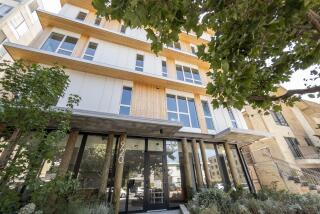Planning That Just Cries Out: Who Designed This, Anyway?
I asked the 40 or so seventh- and eighth-graders how many of them had heard of Measure J. Not one hand went up. I asked how many knew that there will be an election May 14 in Orange County.
Again, not one hand went up.
These students at MacArthur Fundamental Intermediate School in Santa Ana were no academic slouches. They were students in a journalism class who produced their own monthly newspaper, an accomplishment for any high school, let alone a junior high. Their teacher had invited me to talk about what I do as a reporter for The Times.
For the past few months, as war has raged in the Persian Gulf and the Rodney G. King case has thrown Los Angeles into a turmoil, I have been writing about county government and Measure J, the proposed half-cent sales tax to build a new jail.
These junior high students were probably as good a barometer as any about the interest of the general public in many of the issues that I write about. Their reaction reminded me once again that what is brewing in the Hall of Administration, the heart of county government here, or the halls of justice or the chambers of city councils is not necessarily the talk of the town. And that is the bane of government reporters.
For what happens here is stuff of minor drama when placed next to the stories about the Kurds starving as they make their way out of Iraq. We are writing about wrinkles in long-running sagas between developers and planners, environmentalists and developers, politicians and social activists, politicians and the professional staffs of government offices, politicians and everyone else.
There are big things at stake here: millions of dollars to pay for programs such as medical services for the poor, rules of the game for developments worth millions, careers of people who have given their life to government, the political futures of elected officials.
But, to understand these things, a reader must be diligent, following issues through a tangle of bureaucratic procedures.
Sometimes, during the long government sessions devoted to these issues, we reporters wonder, “What does this have to do with people?” At least I do.
The other day at a County Planning Commission meeting, I thought chairman Stephen Nordeck came close to doing the same thing.
A developer came before this august body, armed with slick, colorful charts showing an 84-unit housing project his company wanted to build, full of single-family homes with so-called “zero lot lines”--meaning they basically would have no yards.
He was also proposing that congestion could be avoided because no one would be allowed to park on the street--not even residents. Visitors would park in a lot away from the houses. A homeowners association would enforce the no-parking policy.
Each of the homes had at least three bedrooms, two-car garages and driveways so short that developers decided that residents should be prohibited from parking in them, because cars would overhang into the street.
“What if people don’t want to park in their garages?” Nordeck asked. “What if they’re just going in for a while and need to unload some things? Are you telling me they’ll have to park all the way down at visitor parking?
“Let’s get down to how human beings really live,” he said. And for the next several minutes, he offered the notion that the way we really live does not always fit into the neat charts and zoning descriptions provided by developers, even though they meet county standards. He went on to talk about the right not to park your car in your own garage, and the freedom to park on your own street without fear of your neighbors, and the constant burden government is placing on homeowner associations by asking neighbor to police neighbor.
For an instant, I could feel it in the audience. Those of us covering the meeting leaned forward a little in our red upholstered seats. At last, we all thought to ourselves, a government official who seemed to want to get to the heart of the matter.
He was talking about something that we all could understand. We all have cars, we have all struggled with bags of groceries and left the car in the front of the house to run in and put them on the table before we stored the vehicle in its permanent stable for the night.
We had all seen housing or townhouse or apartment communities built in such a way that we asked: Who designed this thing?
And eventually we all have concluded that perhaps they were designed to get maximum profit for the builder, and minimum comfort for the buyer.
But then, it was over again. The commission voted to delay the matter until further study, a action common to the daily drama played out in these hallowed halls.
Everyone in the audience went home after a while. It had been just another blip in the larger story of how government works, but one that seems much clearer--and closer to home--than so many other meetings that reporters write about.
And I went in search of more meetings to cover.
More to Read
Sign up for Essential California
The most important California stories and recommendations in your inbox every morning.
You may occasionally receive promotional content from the Los Angeles Times.










